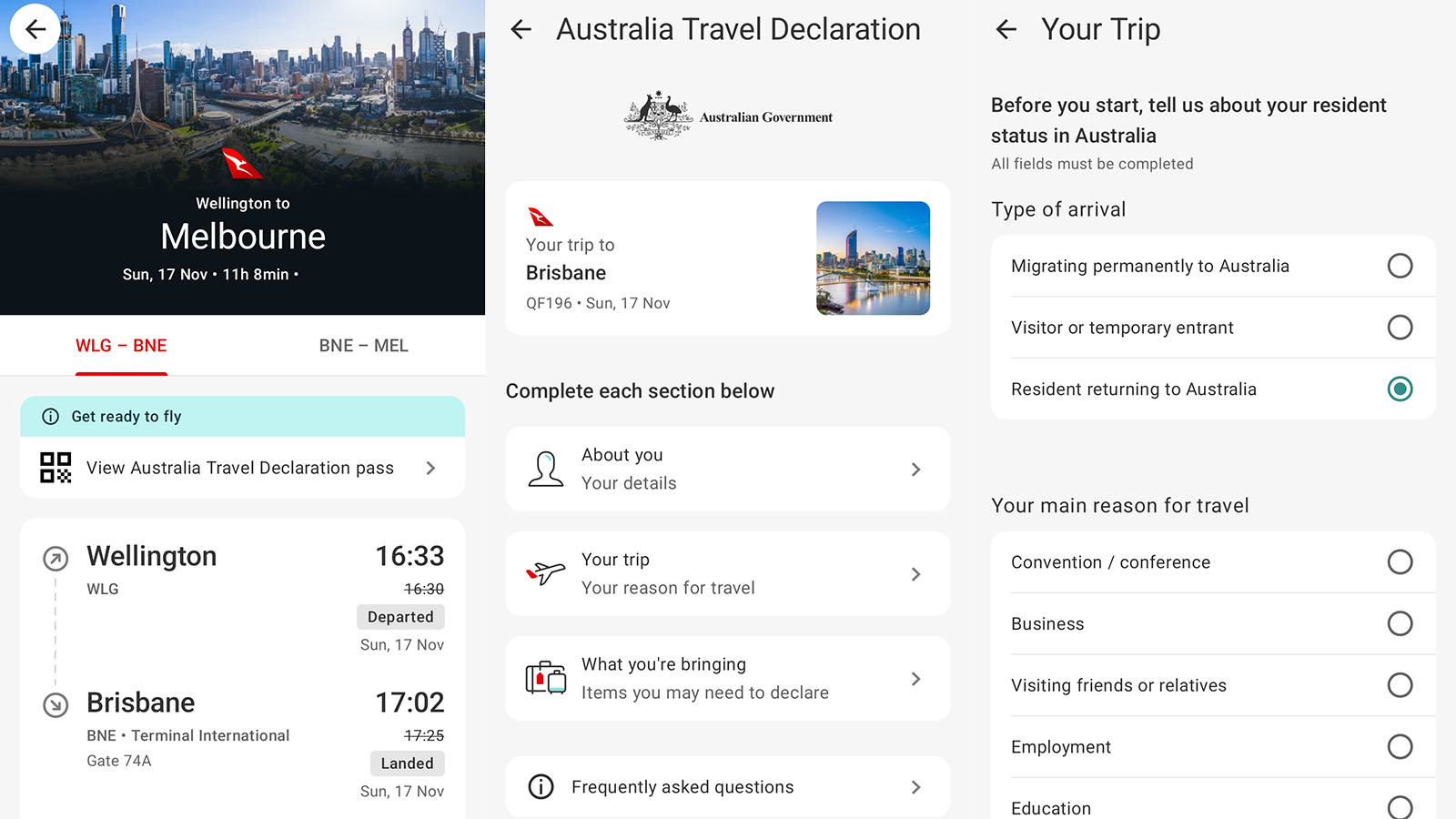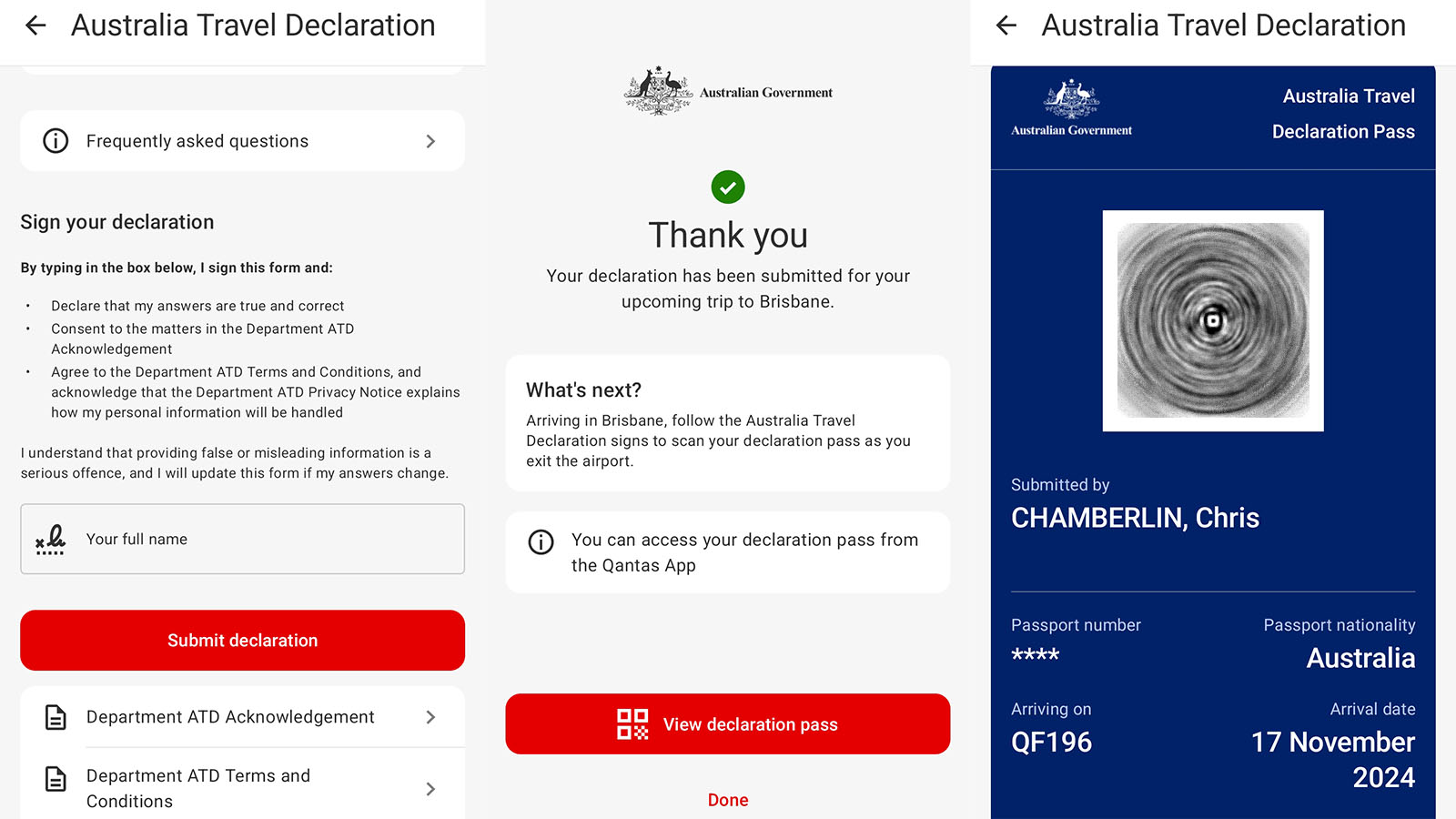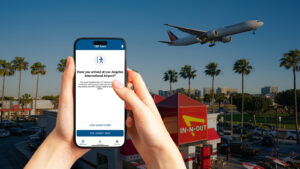As many other countries move to modernise the international arrivals process, Australia is finally getting on board. For years, travellers have needed to complete a handwritten incoming passenger card whenever arriving into Australia. Now, selected flyers are able to trial a paper-free version of the same: the Australia Travel Declaration, or ATD.
The ATD asks exactly the same questions as would be required of the paper form. But it’s something that travellers can complete before even heading to the airport for that Australia-bound flight. With a completed ATD, there’s no need to handwrite anything, or to physically sign any piece of paper. It’s all in the cloud.
I was able to put the Australia Travel Declaration to the test on a recent international flight from Wellington to Brisbane. Here’s how it went.
Who can use the digital Australia Travel Declaration?
Right now, the Australia Travel Declaration is in pilot phase. This means it’s not yet widely available, but you might still chance upon an opportunity to try it out. At the time of writing, it’s available to passengers on selected Qantas-operated flights from New Zealand to Australia.
The list of eligible routes is currently growing, with additional trans-Tasman arrivals continuing to be rolled out progressively. The best way to check whether the Australia Travel Declaration is available for your journey is to open the trip in your Qantas smartphone app. If eligible, you’ll see a prompt for the Australia Travel Declaration within 72 hours of your flight’s scheduled departure time.
The ATD isn’t yet available for those travelling with other airlines. So if you’re arriving from New Zealand aboard Virgin Australia, Jetstar or Air New Zealand, you’ll have to wait a little bit longer. The same is true for passengers carried from New Zealand to Australia on ‘fifth freedom’ services, as operated by China Airlines, China Eastern and Emirates.
For now, you won’t be able to use the ATD if arriving from any other country, even if your flight is operated by Qantas. You must be on a Qantas-operated flight from New Zealand to be in with a chance.
How to complete the Australia Travel Declaration
If eligible to use the Australia Travel Declaration, you’ll be able to lodge it as early as 72 hours before your flight departs, via the Qantas app. The app pre-fills some of the data into the electronic form to help speed things up, including your flight number.

For those who choose to use it, the ATD replaces the handwritten incoming passenger card. That said, using the ATD is by choice. If you prefer, you can stick with the paper form as usual. But the digital form has some advantages, especially if things change.
With a paper-based form, you may need to start over if you make a mistake or something changes. But with the digital Australia Travel Declaration, you can update your responses until you cross the Australian border. As it happens, I did just that, and it was very easy.
Keen to try things out, I completed the form several days before my flight. At that point, I had nothing to declare, so responded accordingly. But when some last-minute shopping would mean a change in declaration, I quickly opened up the app and tweaked things accordingly.
In my case, I’d bought a bar of chocolate to bring home, containing nuts. As nuts are an item of interest at the Australian border, my ‘no’ became a ‘yes’ – and quite easily so. Things are going well so far.

Preparing to travel with the Australia Travel Declaration
I’m well aware that the Australia Travel Declaration is brand new, so I wasn’t expecting things to go smoothly. But even so, opening hiccups are pretty minor.
For one thing, even though I’d completed the ATD via the Qantas app, the Qantas check-in agent in Wellington nestled an Australian incoming passenger card between my boarding passes anyway, when handing them over. I spotted this and handed the card back, but it seemed to have confused others. For instance, I later spotted a couple running into issues with Customs in Brisbane when presenting both a digital and a paper arrivals card for the one flight.
(Pro tip: It’s digital or paper, not both. If you present both, a supervisor needs to amend your immigration record to ‘undo’ the digital declaration and revert to paper processing.)
Speaking of incoming passenger cards, cabin crew were keenly handing these out at the boarding door. This meant handing the form back a second time, after again being bundled back with my boarding pass. In fairness, the crew aren’t going to know that you’ve done the online form, as the boarding pass has no indication of this.
From here, it’s business as usual until landing in Brisbane.
Presenting the digital landing card at the Australian border
Keep in mind that those using the digital Australia Travel Declaration must use SmartGate upon arrival into Australia. You can’t have a digital declaration and be processed via a staffed desk. This means travellers with small children, APEC Business Travel Card holders, diplomats and those requiring manual processing should still use paper forms for now.
As for SmartGate, get your ticket and proceed across the border as normal. But when it comes time to present your declaration, the process is a little different with the ATD. When you’ve completed the declaration electronically, it’ll generate a QR code. Present this QR code on your device when requested, along with your SmartGate ticket.
In fact, keep your eyes peeled for a specific exit path for Australia Travel Declaration holders. Here in Brisbane, those using ATD are currently invited to exit via the channel normally designated as the Express Path and crew exit. In my case, this means bypassing a line of around 200 people in the main queue. Instead, I have only five people in front of me. Winning!
At the checkpoint, my phone remains in my own hand while I scan the QR code. Given my earlier declaration, I’m directed along to biosecurity, as expected. The biosecurity officer scans my code again here but also asks for my passport. It’s the first time I’ve needed to present my passport at this step, and apparently, it’s only because I’ve used the digital pass.
With my hands already trying to juggle my checked bag, cabin bag, my phone and my SmartGate ticket, fishing around for my passport is an unexpected request that slows things down. Especially so, when the modern SmartGate ticket has my photo on it, captured when my passport was scanned upon arrival. But soon enough, I’m pointed towards the exit.
How the process could be improved
On the one hand, things are already working quite well with the Australia Travel Declaration. It’s easy to lodge, easy to update, and Border Force staff aren’t confused when you present it. But things can still be smoother – and that’s what the pilot seeks to explore.
For starters, the check-in process could include a simple on-screen alert for the agent, flagging that an incoming passenger card isn’t necessary. This would speed things up and avoid handing unneeded pieces of paper back and forward. An ‘ATD’ marking on the boarding pass could achieve the same with cabin crew – particularly when handing over arrivals cards at the boarding door, where boarding passes are checked.
But there’s more that could be done at on the Border Force side to make things easier. Given ATD users already need to use SmartGate, why not print the declaration QR code onto the SmartGate ticket itself? After all, it’s already attached to your immigration record, and this would avoid juggling an active smartphone at the exit barrier.
For that matter, why the need to check somebody’s passport a second time, when this was already verified when crossing the border? Why does having a digital pass make this necessary, when those using a handwritten card aren’t asked for the same?
It’s fair to say too, Border Force staff should use simpler English with travellers using the ATD. After scanning my code and seeing my declaration, the agent remarked, ‘what are you declaring at question seven?’. I’ve crossed Australia’s borders more than most, and even then, I don’t have the nature of ‘question seven’ memorised. I do, however, know that somewhere along the way, I ticked yes to an appropriate question. ‘What food are you declaring?’ would be easier to understand.
Summing up
Even with minor hiccups and pain points, it’s great to see the Australia Travel Declaration starting to take shape. With so many countries ditching paper-based arrivals cards in recent years, it’s nice that Australia is finally catching up. It took a while for the departures card to disappear – and now, the arrivals card is shaping up to one day become obsolete.
The use of technology in place of paper plays into longer term plans previously shared by Border Force. The agency hopes to one day remove the SmartGate ticket process entirely and rely much more on facial recognition. We can already see this in its early stages, where the newer SmartGate barriers are cleared simply by approaching them and looking at the camera. At some point, when the kiosks are made obsolete, this will become the first stop on arrival.
With a traveller’s declaration electronically attached to their movement record, even the QR code could become obsolete. At the exit, passengers may simply look into the camera and be directed to the appropriate exit based on what they’ve declared, and any other relevant immigration flags. But for now, the digital declaration is a start. Here’s hoping it gets easier to use and that more travellers can take advantage of it soon.
Would I voluntarily use it again? I’m all for anything that makes the journey easier – and if the ATD continues to grant access to a speedier exit at Customs, I wouldn’t travel without it.
Also read: Save time at US immigration with this official app
Featured image courtesy of Gustavo Fring/Pexels. Chris Chamberlin travelled at Point Hacks’ expense.
Stay up to date with the latest news, reviews and guides by subscribing to Point Hacks’ email newsletter.







Community